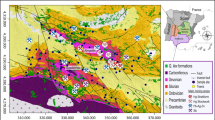Abstract
To fulfill the purpose as a sink for trace elements, soils must not be overloaded with As and Cd. Therefore, it is necessary to get knowledge of the sorption capacities of soils on a regional scale. The determination of these sorption capacities for large areas is, however, impeded by the great expenditure of laboratory work involved. With data presented here retention capacities for cadmium and arsenic from routinely determined soil parameters are estimated. In batch experiments the sorption behaviour of 40 soils from the area of Freiberg/Saxony in Germany was examined. The obtained sorption isotherms from the laboratory were fitted to the Freundlich equation (S = k*Cm). The two constants (k, m) of this equation were used for multiple linear regression to correlate the sorption capacity and the soil parameters, namely clay content, pH value, total organic carbon, and dithionite extractable Fe contents. Due to long lasting ore mining of Freiberg there exist high background levels in that area for the two surveyed elements As and Cd. Therefore, this study offers two different mathematical procedures to take these contaminations into account. Thus the experimental data were corrected before they were fitted to Freundlich and pedotransfer equations were determined. Using the transfer equation, parameter k and m for cadmium sorption could be estimated with statistical certainties of 91% and 61% (adjusted R2), respectively, whereas the predictability for the arsenic sorption is not practicable because achieved R2 values are very low (17% and 7%).
Similar content being viewed by others
References
Adriano D C 1986 Trace Elements in the Terrestrial Environment. Springer Verlag, New York, 533 p.
Alloway B J (Ed.) 1995 Heavy Metals in Soils. 2nd edn. Blackie Academic & Professional, London, 368 p.
Alloway B J, Tills A R and Morgan H 1985 The speciation and availability of cadmium and lead in polluted soils. Trace Sub. Environ. Health 18, 187–201.
Brümmer G W 1986 Heavy metal species, mobility and availability in soils. Z. Pflanzenernähr. Bodenk. 149, 382–398.
Fahrenhorst C 1993 Retardation und Mobilität von Blei, Antimon und Arsen im Boden am Fallbeispiel von Schrotschießplätzen. Bodenökologie und Bodengenese, Berlin, Heft 11, 124 p.
Filius A, Streck T and Richter J 1991 Freundlich-Isothermen für Schwermetalle bei landwirtschaftlich genutzten Böden. Z. angew. Geowiss. 10, 5–14.
Gäth S 1996 Verlagerungspotentiale für Schwermetalle im Boden-Ansätze zur Regionalisierung von Abfallverwertungsflächen in Hessen. Forum Städte-Hygiene 47, 353–357.
Hingston F J, Posner A M and Quirk J P 1971 Competitive adsorption of negatively charged ligands on oxide surfaces. Disc. Faraday Soc. 52, 334–342.
Jakobs L W, Syers J K and Keeney D R 1970 Arsenic sorption by soils. Soil Sci. Soc. Am. Proc. 34, 750–754.
Jarvis S C and Jones L H P 1980 The contents and sorption of cadmium in agricultural soils of England and Wales. J. Soil Sci. 31, 469–479.
Kabata-Pendias A and Pendias H 1992 Trace Elements in Soil and Plants. 2nd edn. CRC Press, Baton Rouge, 374 p.
Livesey N T and Huang P M 1981 Adsorption of arsenate by soils and its relation to selected chemical properties and anions. Soil Sci. 131, 88–94.
Masscheleyn P H, Delaune R D and Patrick Jr W H 1991 Effect of redox potential and pH on arsenic speciation and solubility in a contaminated soil. Envir. Sci. Techn. 25, 1414–1419.
Mehra O P and Jackson M L 1960 Iron oxide removal from soils and clays by a dithionite-citrate system buffered with sodium bicarbonate. Clays and Minerals 7, 317–327.
Sächsisches Landesamt für Umwelt und Geologie (Ed.) 1996a Kartenblatt Freiberg L 5146. 1st edn. Landesvermessungsamt Sachsen, Dresden.
Sächsisches Landesamt für Umwelt und Geologie (Ed.) 1996b Bodenatlas des Freistaates Sachsen. Teil 1 Hintergrundwerte für Schwermetalle und Arsen in landwirtschaftlich genutzten Böden, 27 p.
Sächsisches Landesamt für Umwelt und Geologie (Ed.) 1993 Geogene Belastung der Böden im Raum Freiberg mit Schwermetallen und Arsen, 37 p.
Schlüter K 1997 Sorption of inorganic mercury and monomethyl mercury in an iron-humus podzol soil of southern Norway studied by batch experiments. Envir. Geol. 30, 266–279.
Soon Y K 1981 Solubility and sorption of cadmium in soils amended with sewage sludge. J. Soil Sci. 32, 85–95.
Springob G, Schön A and Böttcher J 1997 Parametrisierung und Regionalisierung der Cd-Sorption sandiger Böden (Pedotransfer-Funktionen). Mitteilgn. Dtsch. Bodenkundl. Ges. 85, 365–368.
VDLUFA 1991 Methodenbuch Band I. Die Untersuchung von Böden. 4. Auflage. Kap. 2.4.3.1VDLUFA-Verlag, Darmstadt.
Zeien H 1995 Chemische Extraktionen zur Bestimmung der Bindungsformen von Schwermetallen in Böden. Bonner Bodenkundliche Abhandlungen. Band 17, 284 p.
Rights and permissions
About this article
Cite this article
Schug, B., Hoß, T., Düring, R.A. et al. Regionalization of sorption capacities for arsenic and cadmium. Plant and Soil 213, 181–187 (1999). https://doi.org/10.1023/A:1004563731376
Issue Date:
DOI: https://doi.org/10.1023/A:1004563731376




